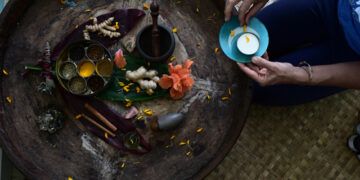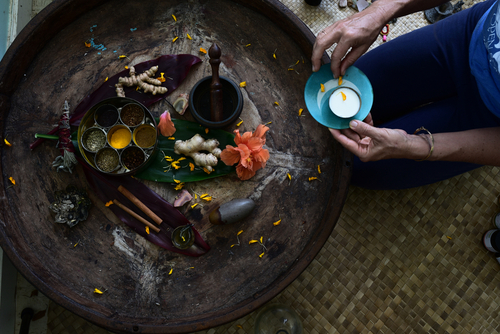Wisdom That Withstood Time
Before wellness became a trend, healing was ritual. Rooted in the earth, guided by seasons, shaped by observation and passed down through generations, traditional healing systems have supported human beings for thousands of years—not just in managing illness, but in cultivating harmony with the body, nature, and spirit.
Ayurveda, Traditional Chinese Medicine (TCM), Indigenous healing, and other time-honored systems didn’t separate physical health from mental and spiritual well-being. They understood what modern life often forgets: healing is relational. It’s about alignment—with the body’s rhythms, with nature’s cycles, with the emotional and energetic layers that make up a human life.
These traditions continue to offer profound insight—not as relics of the past, but as living systems that meet us exactly where we are. Whether you’re seeking support for chronic symptoms, emotional clarity, or simply a deeper sense of connection, exploring these holistic lineages can open doors to healing that feels rooted, whole, and personal.
Ayurveda: Aligning with Nature’s Rhythms
Originating in India over 5,000 years ago, Ayurveda means “the science of life.” It’s a comprehensive system of healing that teaches us to live in harmony with our constitution, the elements, and the cycles of nature.
At the heart of Ayurveda is the concept of the doshas—Vata (air + ether), Pitta (fire + water), and Kapha (earth + water). Each person carries a unique blend of these energies, and when one becomes imbalanced, discomfort or disease can arise.
Rather than suppress symptoms, Ayurvedic practices aim to restore equilibrium through food, herbal remedies, bodywork (like abhyanga oil massage), and lifestyle routines that are attuned to both the individual and the season.
Ayurveda teaches that healing begins with awareness: of how we digest, how we sleep, how we relate to time, and how we process emotion. When we bring presence to these patterns, we begin to align with the body’s natural wisdom.
Traditional Chinese Medicine: Harmony Through Flow
With roots extending back more than 2,500 years, Traditional Chinese Medicine (TCM) is based on the concept of Qi (life force) flowing through the body’s meridians—pathways that connect organ systems and maintain vitality.
Health, in this view, is the result of balanced yin and yang energies and smooth Qi flow. When Qi is blocked, weak, or excessive, symptoms appear. TCM works to correct these imbalances through modalities such as:
-
Acupuncture
-
Herbal medicine
-
Tui na massage
-
Qigong movement and breathwork
-
Dietary therapy based on energetic qualities of food
TCM recognizes the connection between emotion and organ health—for instance, how unprocessed grief can affect the lungs, or how excessive worry can disrupt digestion. It’s a deeply intuitive system that encourages both physical and emotional presence, inviting healing that touches all levels of being.
Indigenous and Earth-Based Healing
Across every continent, Indigenous and ancestral healing practices have supported communities through ceremony, herbal medicine, energy work, and spiritual connection. These systems are diverse and deeply rooted in local ecosystems and cultural wisdom.
Many Indigenous healing traditions emphasize:
-
Relationship with the land and elements
-
Community and collective wellness
-
Honoring ancestors and spiritual guides
-
Healing through ritual, music, storytelling, and energy
For example, in Native American traditions, practices like smudging, sweat lodges, and vision quests are not just physical cleanses—they are spiritual recalibrations. In African and Afro-Caribbean healing, plant spirit medicine, drumming, and ancestral reverence form the core of holistic care.
What these practices often share is a belief that healing is not transactional—it’s sacred, relational, and rooted in connection to something larger than the self.
Shared Principles, Diverse Practices
While each system has its own language and methods, ancient healing traditions often overlap in their understanding of the human experience:
-
The body is intelligent and interconnected
-
Emotional and spiritual states affect physical health
-
Nature is not separate from us—it is the original medicine
-
Healing is a journey, not a destination
These traditions remind us that health is not about achieving perfection—it’s about cultivating balance, honoring our rhythms, and remembering our place within the web of life.
Integrating Ancient Wisdom Today
You don’t need to commit to one path to benefit from these teachings. Begin with curiosity. Sip a warm digestive tea after meals. Explore your energetic tendencies—do you run hot, dry, heavy, scattered? Try acupuncture or qigong. Journal after a walk in nature and listen for what your body is saying.
Modern wellness tends to isolate tools. Ancient healing invites us to weave them. To reconnect with ourselves, not just through protocols, but through presence.
What matters most is that your healing feels personal and rooted in care. Whether you’re drawn to herbs, breath, movement, or ritual, these traditions offer a gentle but profound path inward.
In Closing
Ancient healing systems offer more than techniques—they offer a way of remembering. Remembering that you are part of nature. That your body is wise. That healing unfolds when we slow down, listen, and return to practices that have held humanity for generations.
These traditions still speak—quietly, patiently—asking only that we listen.



























